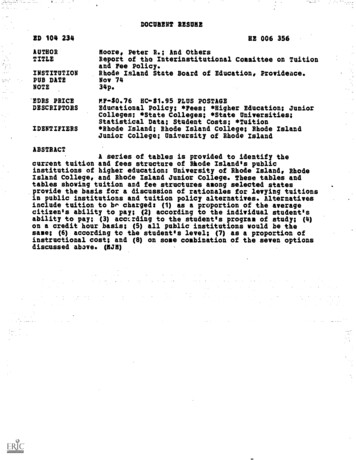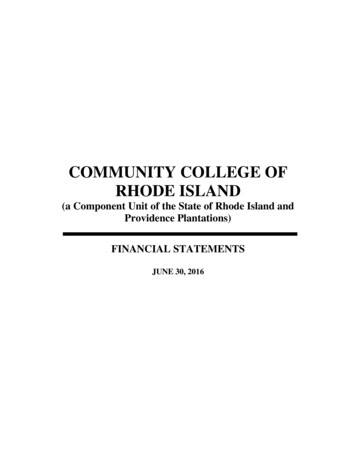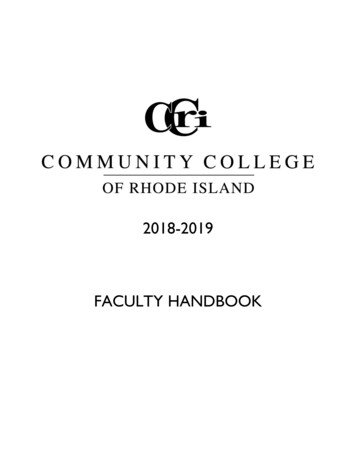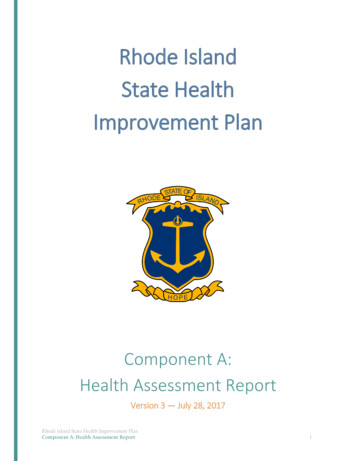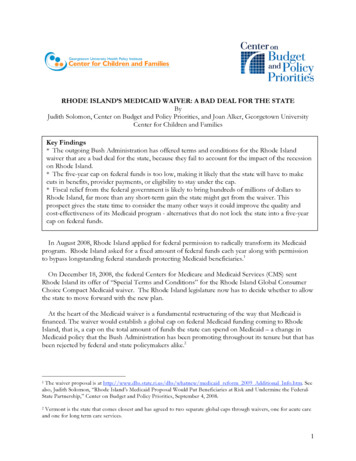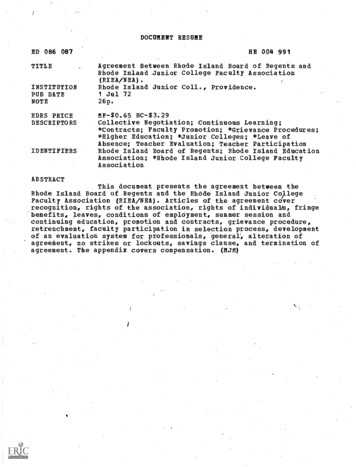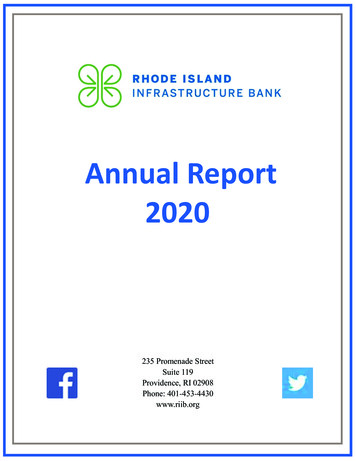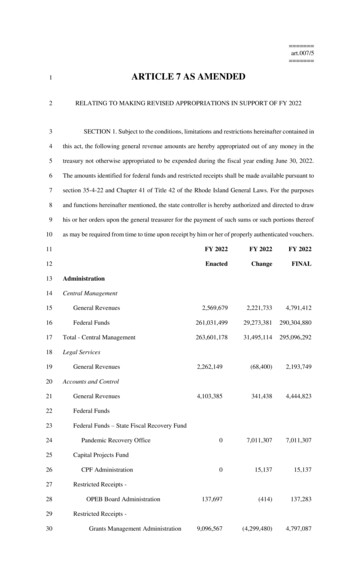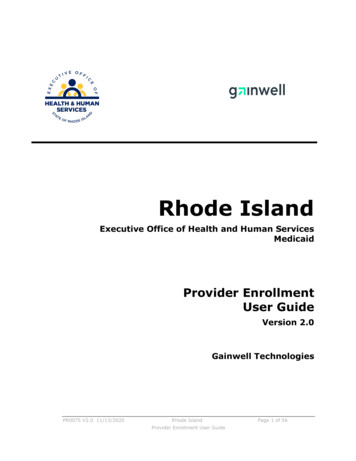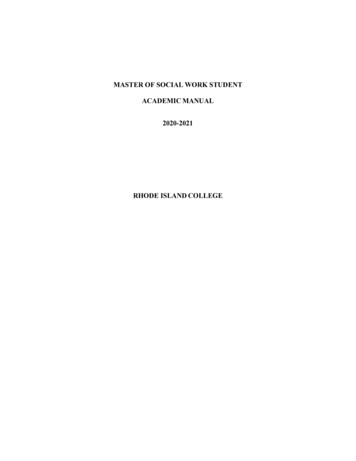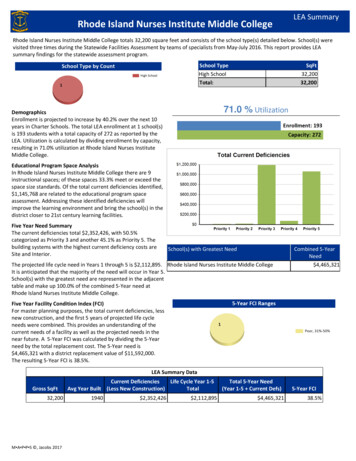
Transcription
Rhode Island Nurses Institute Middle CollegeLEA SummaryRhode Island Nurses Institute Middle College totals 32,200 square feet and consists of the school type(s) detailed below. School(s) werevisited three times during the Statewide Facilities Assessment by teams of specialists from May-July 2016. This report provides LEAsummary findings for the statewide assessment program.School TypeHigh SchoolTotal:SqFt32,20032,20071.0 % UtilizationDemographicsEnrollment is projected to increase by 40.2% over the next 10years in Charter Schools. The total LEA enrollment at 1 school(s)is 193 students with a total capacity of 272 as reported by theLEA. Utilization is calculated by dividing enrollment by capacity,resulting in 71.0% utilization at Rhode Island Nurses InstituteMiddle College.Educational Program Space AnalysisIn Rhode Island Nurses Institute Middle College there are 9instructional spaces; of these spaces 33.3% meet or exceed thespace size standards. Of the total current deficiencies identified, 1,145,768 are related to the educational program spaceassessment. Addressing these identified deficiencies willimprove the learning environment and bring the school(s) in thedistrict closer to 21st century learning facilities.Five Year Need SummaryThe current deficiencies total 2,352,426, with 50.5%categorized as Priority 3 and another 45.1% as Priority 5. Thebuilding systems with the highest current deficiency costs areSite and Interior.School(s) with Greatest NeedThe projected life cycle need in Years 1 through 5 is 2,112,895. Rhode Island Nurses Institute Middle CollegeIt is anticipated that the majority of the need will occur in Year 5.School(s) with the greatest need are represented in the adjacenttable and make up 100.0% of the combined 5-Year need atRhode Island Nurses Institute Middle College.Combined 5-YearNeed 4,465,321Five Year Facility Condition Index (FCI)For master planning purposes, the total current deficiencies, lessnew construction, and the first 5 years of projected life cycleneeds were combined. This provides an understanding of thecurrent needs of a facility as well as the projected needs in thenear future. A 5-Year FCI was calculated by dividing the 5-Yearneed by the total replacement cost. The 5-Year need is 4,465,321 with a district replacement value of 11,592,000.The resulting 5-Year FCI is 38.5%.LEA Summary DataGross SqFt32,200MඵAඵPඵPඵ Ξ͕ :ĂĐŽďƐ ϮϬϭϳCurrent DeficienciesLife Cycle Year 1-5Avg Year Built (Less New Construction)Total1940 2,352,426 2,112,895Total 5-Year Need(Year 1-5 Current Defs) 4,465,3215-Year FCI38.5%
Rhode Island Nurses Institute Middle CollegeMඵAඵPඵPඵ Ξ͕ :ĂĐŽďƐ ϮϬϭϳLEA Summary
Facility Condition AssessmentCharter - Rhode Island Nurses Institute Middle CollegeJune 2017150 Washington St, Providence, RI 02903MඵAඵPඵPඵ Ξ͕ :ĂĐŽďƐ ϮϬϭϳ1
Facility Condition AssessmentCharter - Rhode Island Nurses Institute Middle CollegeIntroductionRhode Island Nurses Institute Middle College, located at 150 Washington St in Providence, Rhode Island, wasbuilt in 1940. It comprises 32,200 gross square feet. Each school across the district was visited three timesduring the Facility Condition Assessments by three teams of specialists in the spring/summer of 2016.Rhode Island Nurses Institute Middle College serves grades 10 - 12, has 9 instructional spaces, and has anenrollment of 193. Instructional spaces are defined as rooms in which a student receives education. The LEAreported capacity for Rhode Island Nurses Institute Middle College is 272 with a resulting utilization of 71%.For master planning purposes a 5-year need was developed to provide an understanding of the current need aswell as the projected needs in the near future. For Rhode Island Nurses Institute Middle College the 5-year needis 4,465,321. The findings contained within this report resulted from an assessment of building systemsperformed by building professionals experienced in disciplines including: architecture, mechanical, plumbing,electrical, acoustics, hazardous materials, and technology infrastructure.Figure 1: Aerial view of Rhode Island Nurses Institute Middle CollegeMඵAඵPඵPඵ Ξ͕ :ĂĐŽďƐ ϮϬϭϳ2
Facility Condition AssessmentCharter - Rhode Island Nurses Institute Middle CollegeApproach and MethodologyA facility condition assessment evaluates each building¶s overall condition. Two components of the facilitycondition assessment are combined to total the cost for facility need. The two components of the facilitycondition assessment are current deficiencies and life cycle forecast.Current Deficiencies: Deficiencies are items in need of repair or replacement as a result of being broken,obsolete, or beyond useful life. The existing deficiencies that currently require correction are identified andassigned a priority. An example of a current deficiency might include a broken lighting fixture or an inoperableroof top air conditioning unit.Life Cycle Forecast: Life cycle analysis evaluates ages of a building's systems to forecast system replacementas they reach the end of serviceable life. An example of a life cycle system replacement is a roof with a 20-yearlife that has been in place for 15 years and may require replacement in five years.Discipline Specialists OO DVVHVVPHQW WHDPV SURGXFHG FXUUHQW GHILFLHQFLHV DVVRFLDWHG ZLWK HDFK VFKRRO 7KH DVVHVVPHQW IRU WKH school facilities at the Rhode Island Department of Education included several specialties:Facility Condition Assessment: Architectural, mechanical, and electrical engineering professionals observedconditions via a visual observation that did not include intrusive measures, destructive investigations, or testing.Additionally, the assessment incorporated input provided by district facilities and maintenance staff whereapplicable. The assessment team recorded existing conditions, identified problems and deficiencies,documented corrective action and quantities, and identified the priority of the repair in accordance withparameters defined during the planning phase. The team took digital photos at each school to better identifysignificant deficiencies.Technology: Technology specialists visited RIDE facilities and met with technology directors to observe andDVVHVV HDFK IDFLOLW\ V WHFKQRORJ\ LQIUDVWUXFWXUH 7KH DVVHVVPHQW LQFOXGHG QHWZRUN DUFKLWHFWXUH PDMRU infrastructure components, classroom instructional systems, necessary building space and support fortechnology. The technology assessment took into account the desired technology outcome and best practicesand processes to ensure results can be attained effectively.Hazardous Materials: Schools constructed prior to 1990 were assessed by specialists to identify the presence ofhazardous materials. The team focused on identifying asbestos containing building materials (ACBMs), leadbased painted (LBP) areas, polychlorinated biphenyls (PCBs), and chlorofluorocarbons (CFCs). As part of anindoor air and exterior air quality assessment, the team noted evidence of mold, water intrusion, mercury, andoil and hazardous materials (OHMs) exposure. If sampling and analysis was required, these activities wererecommended but not included in the scope of work.Traffic: A traffic specialist performed an in-office review of aerial imagery of the traffic infrastructure around thefacilities in accordance with section 1.05-7 in the Rhode Island School Construction Regulations and revieweddata collected on site during the facility condition assessment. Based on this information, deficiencies andFRUUHFWLYH DFWLRQV ZHUH LGHQWLILHG LJK SUREOHP DUHDV ZHUH LGHQWLILHG IRU FRQVLGHUDWLRQ RI PRUH GHWDLOHG VLWH specific study and analysis in the future.Acoustics: Specialists assessed each school's acoustics, including architectural acoustics, mechanical systemnoise and vibration, and environmental noise. The assessment team evaluated room acoustics with particularattention to the intelligibility of speech in learning spaces, interior and exterior sound isolation, and mechanicalsystem noise and vibration control.Educational Program Space Assessment: Teams evaluated schools to ensure that that all spaces adequatelysupport the districts educational program. Standards are established for each classroom type or instructionalspace. Each space is evaluated to determine if it meets those standards and a listing of alterations that shouldbe made to make the space a better environment for teaching and learning was created.MඵAඵPඵPඵ Ξ͕ :ĂĐŽďƐ ϮϬϭϳ3
Facility Condition AssessmentCharter - Rhode Island Nurses Institute Middle CollegeSystem SummariesThe following tables summarize major building systems at the Rhode Island Nurses Institute Middle Collegecampus, identified by discipline and building.SiteThe site level systems for this campus include:Building EnvelopeThe exterior systems for the building(s) at this campus includes:01 - Main Building:Brick Exterior WallAluminum Exterior WindowsSteel Exterior Entrance DoorsThe roofing for the building(s) at this campus consists of:01 - Main Building:Built-Up Roofing With BallastInteriorThe interior systems for the building(s) at this campus include:01 - Main Building:Steel Interior DoorsWood Interior DoorsInterior Door HardwareSuspended Acoustical Grid SystemSuspended Acoustical Ceiling TileCeramic Tile WallInterior Wall PaintingCeramic Tile FlooringVinyl Composition Tile FlooringEpoxy Coated FlooringCarpetMechanicalThe mechanical systems for the building(s) at this campus include:01 - Main Building:Finned Wall RadiatorElectronic Heating System Controls3 Ton Outside Water Cooled Condenser10 Ton Condensing Unit3 Ton Fan Coil - Water Cool/Water Heat2-Pipe Steam Hydronic Distribution SystemDuctworkSmall Roof Exhaust FanWall Exhaust FanMඵAඵPඵPඵ Ξ͕ :ĂĐŽďƐ ϮϬϭϳ4
Facility Condition AssessmentCharter - Rhode Island Nurses Institute Middle College01 - Main Building:Fire Sprinkler SystemPlumbingThe plumbing systems for the building(s) at this campus include:01 - Main Building:Domestic Water Piping SystemClassroom LavatoriesMop/Service SinksRefrigerated Drinking FountainRestroom LavatoriesToiletsUrinalsElectricalThe electrical systems for the building(s) at this campus include:01 - Main Building:1,200 Amp SwitchgearPanelboard - 120/208 100APanelboard - 120/240 225AElectrical DisconnectLight FixturesMඵAඵPඵPඵ Ξ͕ :ĂĐŽďƐ ϮϬϭϳ5
Facility Condition AssessmentCharter - Rhode Island Nurses Institute Middle CollegeFacility Deficiency Priority LevelsDeficiencies were ranked according to five priority levels, with Priority 1 items being the most critical to address:Priority 1 Mission Critical Concerns: Deficiencies or conditions that may directly affect the school¶s ability toUHPDLQ RSHQ RU GHOLYHU WKH HGXFDWLRQDO FXUULFXOXP 7KHVH GHILFLHQFLHV W\SLFDOO\ UHODWH WR EXLOGLQJ VDIHW\ FRGH compliance, severely damaged or failing building components, and other items that require near-term correction.An example of a Priority 1 deficiency is a fire alarm system replacement.Priority 2 Indirect Impact to Educational Mission: Items that may progress to a Priority 1 item if not addressed inthe near term. Examples of Priority 2 deficiencies include inadequate roofing that could cause deterioration ofintegral building systems, and conditions affecting building envelopes, such as roof and window replacements.Priority 3 Short-Term Conditions: Deficiencies that are necessary to the school's mission but may not requireLPPHGLDWH DWWHQWLRQ 7KHVH LWHPV VKRXOG EH FRQVLGHUHG QHFHVVDU\ LPSURYHPHQWV UHTXLUHG WR PD[LPL]H IDFLOLW\ efficiency and usefulness. Examples of Priority 3 items include site improvements and plumbing deficiencies.Priority 4 Long-Term Requirements: Items or systems that may be considered improvements to the instructionalHQYLURQPHQW 7KH LPSURYHPHQWV PD\ EH DHVWKHWLF RU SURYLGH JUHDWHU IXQFWLRQDOLW\ ([DPSOHV LQFOXGH FDELQHWV finishes, paving, removal of abandoned equipment, and educational accommodations associated with specialprograms.Priority 5 Enhancements: Deficiencies aesthetic in nature or considered enhancements. Typical deficiencies inthis priority include repainting, replacing carpet, improved signage, or other improvements to the facilityenvironment.MඵAඵPඵPඵ Ξ͕ :ĂĐŽďƐ ϮϬϭϳ6
Facility Condition AssessmentCharter - Rhode Island Nurses Institute Middle CollegeThe following chart summarizes this site's current deficiencies by building system and priority. The listing detailscurrent deficiencies including deferred maintenance, functional deficiencies, code compliance, capital renewal,hazardous materials and technology categories.Table 1: System by PriorityPrioritySystem12345% of TotalTotalSite-- 4,588 28,674 1,015,945 1,049,20744.60 %Roofing----- 00.00 %Structural----- 00.00 %Exterior----- 00.00 %Interior-- 478,127 22,783 20,814 521,72422.18 %Mechanical- 17,802 308,892 22,254- 348,94814.83 %Electrical---- 8,037 8,0370.34 %Plumbing---- 7,650 7,6500.33 % 11,547---- 11,5470.49 %Technology-- 396,652-- 396,65216.86 %Conveyances----- 00.00 %0.37 %Fire and Life SafetySpecialtiesTotal---- 8,661 8,661 11,547 17,802 1,188,259 73,711 1,061,107 2,352,426*Displayed totals may not sum exactly due to mathematical roundingThe building systems with the most need include:Site- 1,049,207Interior- 521,724Technology- 396,652The chart below represents the building systems and associated deficiency costs.Figure 2: System DeficienciesMඵAඵPඵPඵ Ξ͕ :ĂĐŽďƐ ϮϬϭϳ7
Facility Condition AssessmentCharter - Rhode Island Nurses Institute Middle CollegeCurrent Deficiencies by CategoryDeficiencies have been further grouped according to the observed category. Acoustics deficiencies relate to room acoustics, sound insolation, and mechanical systems and vibrationcontrol modeled after ANSI/ASA Standard S12.60-2010 and ASHRAE Handbook, Chapter 47 on Sound andVibration Control. Barrier to Accessibility deficiencies relate to the Americans with Disabilities Act and the Rhode Island*RYHUQRUV &RPPLVVLRQ RQ 'LVDELOLW\ GGLWLRQDO LWHPV UHODWHG WR DFFHVVLELOLW\ PD\ EH LQFOXGHG RWKHU categories. Capital Renewal items have reached or exceeded serviceable life and require replacement. These are currentDQG GR QRW LQFOXGH OLIH F\FOH FDSLWDO UHQHZDO IRUHFDVWV OVR LQFOXGHG DUH GHILFLHQFLHV FRUUHFWLQJ SODQQHG ZRUN postponed beyond its regular life expectancy. Code Compliance GHILFLHQFLHV UHODWHG WR FXUUHQW FRGHV 0DQ\ PD\ IDOO XQGHU JUDQGIDWKHU FODXVHV ZKLFK DOORZ EXLOGLQJV WR FRQWLQXH RSHUDWLQJ XQGHU FRGHV HIIHFWLYH DW WKH WLPH RI FRQVWUXFWLRQ RZHYHU WKHUH DUH instances where the level of renovation requires full compliance which are reflected in the master plan. Educational Adequacy deficiencies identify where facilities do not align with the Basic Education Program andthe RIDE School Construction Regulations. Functional Deficiencies are deficiencies for components or systems that have failed before the end ofexpected life or are not the right application, size, or design. Hazardous Materials include deficiencies for building systems or components containing potentiallyhazardous material. The team focused on identifying asbestos containing building materials (ACBMs), leadbased painted (LBP) areas, polychlorinated biphenyls (PCBs), and chlorofluorocarbons (CFCs). As part of anindoor air and exterior air quality assessment, the team noted evidence of mold, water intrusion, mercury, andoil and hazardous materials (OHMs) exposure. With other scopes of work there may be other costs associatedwith hazardous materials. Technology deficiencies relate to network architecture, technology infrastructure, classroom systems, andVXSSRUW ([DPSOHV RI WHFKQRORJ\ GHILFLHQFLHV LQFOXGH VHFXULW\ FDPHUDV VHFXUH HOHFWURQLF DFFHVV WHOHSKRQH handsets, and dedicated air conditioning for telecommunication rooms. Traffic deficiencies relate to vehicle or pedestrian traffic, such as bus loops, crosswalks, and pavementmarkings.MඵAඵPඵPඵ Ξ͕ :ĂĐŽďƐ ϮϬϭϳ8
Facility Condition AssessmentCharter - Rhode Island Nurses Institute Middle College7KH IROORZLQJ FKDUW DQG WDEOH UHSUHVHQW WKH GHILFLHQF\ FDWHJRU\ E\ SULRULW\ 7KLV OLVWLQJ LQFOXGHV FXUUHQW GHILFLHQFLHV IRU DOO EXLOGLQJ V\VWHPV Table 2: Deficiency Category by PriorityPriorityCategory1234Total5Acoustics-- 235,893-- 235,893Barrier to Accessibility----- 0Capital Renewal- 17,802 551,126-- 568,928Code Compliance----- 0 11,547-- 73,143 1,061,078 1,145,768Functional Deficiency----- 0Hazardous Material--- 568 29 597Technology-- 396,652-- 396,652Educational AdequacyTrafficTotal-- 4,588-- 4,588 11,547 17,802 1,188,259 73,711 1,061,107 2,352,426*Displayed totals may not sum exactly due to mathematical roundingMඵAඵPඵPඵ Ξ͕ :ĂĐŽďƐ ϮϬϭϳ9
Facility Condition AssessmentCharter - Rhode Island Nurses Institute Middle CollegeLife Cycle Capital Renewal Forecast'XULQJ WKH IDFLOLW\ FRQGLWLRQ DVVHVVPHQW DVVHVVRUV LQVSHFWHG DOO PDMRU EXLOGLQJ V\VWHPV ,I D QHHG IRU immediate replacement was identified, a deficiency was created with the estimated repair costs. The identifieddeficiency contributes to the facility's total current repair costs.Capital planning scenarios span multiple years, as opposed to being constrained to immediate repairs.Construction projects may begin several years after the initial facility condition assessment. Therefore, inaddition to the current year repair costs, it is necessary to forecast the facility's future costs using a 5-year lifeF\FOH UHQHZDO IRUHFDVW PRGHO Life cycle renewal is the projection of future building system costs based upon each individual system¶sexpected serviceable life. Building systems and components age over time, eventually break down, reach theend of their useful lives, and may require replacement. While an item may be in good condition now, it mightreach the end of its life before a planned construction project occurs.The following chart shows all current deficiencies and the subsequent 5-year life cycle capital renewalprojections. The projections outline costs for major building systems in which a component is expected to reachthe end of its useful life and require capital funding for replacement.Table 3: Capital Renewal ForecastLife Cycle Capital Renewal ProjectionsSystemCurrent DeficienciesYear 12017Year 22018Year 32019Year 42020Year 52021LC Yr. 1-5 TotalTotal 5-Year Need 1,049,207 0 0 0 0 0 0 1,049,207Roofing 0 0 0 0 0 619,708 619,708 619,708Structural 0 0 0 0 0 0 0 0Exterior 0 0 0 0 0 0 0 0Interior 521,724 0 0 0 350,138 265,820 615,958 1,137,682Mechanical 348,948 0 0 0 0 0 0 348,948 8,037 0 0 0 1,855 1,855 3,710 11,747 15,117SiteElectricalPlumbingFire and Life SafetyTechnologyConveyancesSpecialtiesTotal 7,650 0 0 0 7,467 0 7,467 11,547 0 0 0 0 0 0 11,547 396,652 0 0 0 0 0 0 396,652 0 0 0 0 0 866,052 866,052 866,052 8,661 0 0 0 0 0 0 8,661 2,352,426 0 0 0 359,460 1,753,435 2,112,895 4,465,321*Displayed totals may not sum exactly due to mathematical roundingMඵAඵPඵPඵ Ξ͕ :ĂĐŽďƐ ϮϬϭϳ10
Facility Condition AssessmentCharter - Rhode Island Nurses Institute Middle CollegeFacility Condition Index (FCI)The Facility Condition Index (FCI) is used throughout the facility condition assessment industry as a generalindicator of a building¶s health. Since 1991, the facility management industry has used an index called the FCIto benchmark the relative condition of a group of schools. The FCI is derived by dividing the total repair cost,including educational adequacy and site-related repairs, by the total replacement cost. A facility with a higherFCI percentage has more need, or higher priority, than a facility with a lower FCI. It should be noted that costs inthe New Construction category are not included in the FCI calculation.Financial modeling has shown that over a 30-year period, it is more cost effective to replace than repair schoolswith a FCI of 65 percent or greater. This is due to efficiency gains with facilities that are more modern and thevalue of the building at the end of the analysis period. It is important to note that the FCI at which a facility shouldbe considered for replacement is typically debated and adjusted based on property owners and facility managersapproach to facility management. Of course, FCI is not the only factor used to identify buildings that needrenovation, replacement, or even closure. Historical significance, enrollment trends, community sentiment, andthe availability of capital are additional factors that are analyzed when making school facility decisions.For master planning purposes, the total current deficiencies and the first five years of projected life cycle needswere combined. This provides an understanding of the current needs of a facility as well as the projected needsin the near future. A 5-year FCI was calculated by dividing the 5-year need by the total replacement cost. Costsassociated with new construction are not included in the FCI calculation.The replacement value represents the estimated cost of replacing the current building with another building oflike size, based on today¶s estimated cost of construction in the Providence, Rhode Island area. The estimatedreplacement cost for this facility is 11,592,000. For planning purposes, the total 5-year need at the RhodeIsland Nurses Institute Middle College is 4,465,321 (Life Cycle Years 1-5 plus the FCI deficiency cost). TheRhode Island Nurses Institute Middle College facility has a 5-year FCI of 38.52%.Figure 5: 5-Year FCIIt is important to reiterate that this FCI replacement threshold is not conclusive, but is intended to initiateplanning discussion in which other relevant issues with regard to a facility¶s disposition must be incorporated.This merely suggests where conversations regarding replacement might occur.MඵAඵPඵPඵ Ξ͕ :ĂĐŽďƐ ϮϬϭϳ11
Facility Condition AssessmentCharter - Rhode Island Nurses Institute Middle CollegeRhode Island Aspirational CapacityThe capacity of a school reflects how many students the school¶s physical facility can effectively serve. Thereare various methodologies that exist to calculate capacity. It is not uncommon to review an existing building onlyto find that the capacity that had once been assigned is greater than what can be reasonably accommodatedtoday. This is primarily because of a change in how programs are delivered.The Rhode Island Aspirational Capacity is based on the Rhode Island School Construction Regulations (SCRs)and is an aspirational goal of space use. The capacity for each individual public school in the state of RhodeIsland was designed to conform to Section 1.06-2 Space Allowance Guidelines of the Rhode Island Departmentof Education (RIDE) SCRs. These regulations outline the allowed gross square feet (GSF) per student at eachschool type (ES, MS, HS) by utilizing a sliding scale based on projected enrollment. The resulting capacitiesreflect how school capacities align to the SCRs for new construction. The existing enrollment was multiplied bythe GSF per student for the appropriate bracket. For the purposes of this analysis, Pre-K centers were rolled intothe elementary totals, and K-8 facilities were counted as middle schools.The most consistent and equitable way a state can determine school capacities across a variety of districts andeducational program offerings is to use square-foot-per-student standards. In contrast, in the 2013 PublicSchoolhouse Assessment Report, LEAs self-reported capacities for their elementary, middle and high schools.Districts typically report ³functional capacity, which is defined as the number of students each classroom canaccommodate. Functional capacity counts how many students can occupy a space, not how much roomstudents and teachers have within that space. For example, a 650-square-foot classroom and a 950-square-footclassroom can both have a reported capacity of 25 students, but the actual teaching and learning space perstudent varies greatly.The variation in square feet per student impacts the kinds of teaching practices possible in each space. Thelowest allocation of space per student restricts group and project-based learning strategies and requiresteachers to teach in more traditional, lecture-style formats, due to a lack of space. Furthermore, the number ofstudents that can be accommodated in a classroom does not account for access to sufficient common spacessuch as libraries, cafeterias, and gymnasiums. When cafeterias are undersized relative to the population,schools must host four or more lunch periods a day, resulting in some students eating lunch mid-morning andsome mid-afternoon. Similarly, undersized libraries and gymnasiums create scheduling headaches for schoolsand restrict student access. Finally, a classroom count-only approach to school capacity does not consider theinherent scheduling challenges schools face.Applying the Rhode Island Aspirational Capacity, a facility of this size could ideally support an enrollment ofapproximately 157 students.Facility New ConstructionAs part of the Educational Program Space Assessment, select core spaces were compared to the RI SchoolConstruction Regulations. If it was determined that a facility was in need of square footage related to a cafeteriaor library/media center, a cost for additional space was estimated. This cost is not included in the total 5-yearneed or the 5-year FCI calculation.The New Construction cost to bring the Rhode Island Nurses Institute Middle College cafeteria and/orlibrary/media center to the size prescribed by the SCRs is estimated to be 0.MඵAඵPඵPඵ Ξ͕ :ĂĐŽďƐ ϮϬϭϳ12
Facility Condition AssessmentCharter - Rhode Island Nurses Institute Middle CollegeSummary of FindingsThe Rhode Island Nurses Institute Middle College comprises 32,200 square feet and was constructed in 1940.Current deficiencies at this school total 2,352,426. Five year capital renewal costs total 2,112,895. The totalidentified need for the Rhode Island Nurses Institute Middle College (current deficiencies and 5-year capitalrenewal costs) is 4,465,321. The 5-year FCI is 38.52%.Table 4: Facility Condition by BuildingGross Sq FtRhode Island Nurses Institute Middle College Totals32,200Year Built1940CurrentDeficiencies 2,352,426LC Yr. 1-5 Total 2,112,895Total 5 Yr Need(Yr 1-5 Current Defs)5-Year FCI 4,465,32138.52%*Displayed totals may not sum exactly due to mathematical roundingThe following pages provide a listing of all current deficiencies and 5-year life cycle need and the associatedcosts, followed by photos taken during the assessment.Cost EstimatingCost estimates are derived from local cost estimating expertise and enhanced by industry best practices,historical cost data, and relevance to the Rhode Island region. Costs have been developed from current marketrates as of the 2nd quarter in 2016. All costs are based on a replace-in-kind approach, unless the item was not incompliance with national or state regulations or standards.For planning and budgeting purposes, facility assessments customarily add a soft cost multiplier onto deficiencyrepair cost estimates. This soft cost multiplier accounts for costs that are typically incurred when contracting forrenovation and construction services. Soft costs typically include construction cost factors, such as contractoroverhead and profit, as well as labor and material inflation, professional fees, and administrative costs. Based onthe Rhode Island School Construction Regulations, a soft cost multiplier of 20% is included on all cost estimates.Other project allowances are included in the cost estimates based on school attributes such as age, location,and historic designation. All stated costs in the assessment report will include soft costs for planning andbudgeting purposes. These are estimates, and costs will vary at the time of construction.MඵAඵPඵPඵ Ξ͕ :ĂĐŽďƐ ϮϬϭϳ13
Facility Condition AssessmentCharter - Rhode Island Nurses Institute Middle CollegeSite Level DeficienciesSiteDeficiencyCategoryCrosswalk Requires RepaintingTrafficNote:EducationalAdequacy1 Ea.5 64,800 54984EducationalAdequacy1 Ea.5 163,566 29068EducationalAdequacy1 Ea.5 210,276 28342EducationalAdequacy1 Ea.5 95,580 28210EducationalAdequacy1 Ea.5 152,928 28385EducationalAdequacy1 Ea.5 328,795 28294Sub Total for System8 items 1,049,207Sub Total for School and Site Level8 items 1,049,207Backstops Require ReplacementPE / Recess Playfield is Missing and is NeededSchool has insufficient # of tennis courts.School has insufficient baseball fields.School has insufficient football/soccer fields.School has insufficient softball fields.Note:School has insufficient softball fields.School lacks a competition track.Note:ID 28,674 28655School has insufficient football/soccer fields.Note: 4,588 250834School has insufficient baseball fields.Note:Repair Cost1 Ea.School has insufficient # of tennis courts.Note:3EducationalAdequacyPE / Recess Playfield is Missing and is NeededNote:Priority6 Ea.Repaint crosswalks at corner of Washington St and Mathewson St (4) and Washington and Snow St (2)Backstops Require ReplacementNote:Qty UoMSchool lacks a competition track.Building: 01 - Main BuildingInteriorDeficiencyCategoryQty UoMPriorityClassroom Entry Doors Provide Insufficient Sound IsolationAcoustics28 Ea.3 235,893 27894Note:Repair CostIDAll ClassroomsThe Carpet Flooring Requires ReplacementCapital Renewal11,000 SF3 242,234 24885Paint (probable pre-1978 in base layer(s)) - large areas ( 10 sq. ft.) of peeling/damage &area in active use - children (measurement unit - square feet)Hazardous Material26 SF4 250 RollupPaint (probable pre-1978 in base layer(s)) - damaged area 9 sq. ft. AND NOT in childrenaccessible area (measurement unit - square feet)Hazardous Material5 SF4 48 RollupRoom Lighting Is Inadequate Or In Poor Condition.EducationalAdequacy576 SF4 22,215 RollupWall/ceiling materials - area 9 sq. ft. AND in children-accessible areaHazardous Material4 SF4 39 RollupWall/ceiling materials - large areas ( 10 sq. ft.) of damage & area in active use - childrenHazardous Material24 SF4 231 RollupClassroom Door Requires Vision PanelEducationalAd
Rhode Island Nurses Institute Middle College, located at 150 Washington St in Providence, Rhode Island, was built in 1940. It comprises 32,200 gross square feet. Each school across the district was visited three times during the Facility Condition Assessments by three teams of specialists in the spring/summer of 2016.
